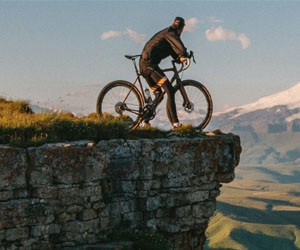


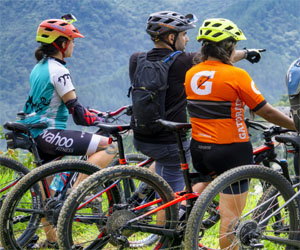
Mountain biking, with its rugged terrains and thrilling trails, has a special allure for those seeking adventure and outdoor excitement. For beginners, it can be an intimidating sport, but it's also a gateway to exploration, fitness, and a lifelong love for the great outdoors. In this article, we'll delve into the world of mountain biking from a beginner's perspective and provide essential tips for a successful journey.
Start With The Basics: As a beginner, it's crucial to begin with the fundamentals. Invest in a suitable mountain bike that matches your budget and riding goals. Entry-level mountain bikes are readily available and offer a solid starting point. Familiarize yourself with the bike's components and learn basic maintenance to keep it in good working condition.
Safety First: Safety should be your top priority. Always wear a properly fitted helmet and gloves, and consider protective gear like knee and elbow pads. Ensuring that your bike has functioning brakes and reliable tires is essential for a safe ride.
Choose The Right Trail: Start on beginner-friendly trails. Look for well-marked, easy-to-moderate paths that provide a comfortable introduction to mountain biking. These trails typically have fewer obstacles and gentler inclines, making them ideal for beginners.
Learn The Techniques: Mountain biking involves specific techniques that are important for both safety and enjoyment. Focus on body positioning, balance, and weight distribution to maintain control on uneven terrain. Learning to navigate obstacles, handle steep descents, and manage your speed on downhills is crucial.
Ride With Others: Riding with experienced friends or joining a beginner's group ride can be immensely helpful. You can learn from their experience and get tips on tackling obstacles or mastering techniques. Additionally, riding with others can provide a sense of camaraderie and motivation.
Gradual Progression: Don't rush your progression. As you gain confidence and skills, you can start exploring more challenging trails. It's important to understand your limits and gradually push them while staying within your comfort zone.
Be Mindful Of The Environment: Respect the natural environment and the trails you ride on. Follow trail rules and guidelines, and avoid disturbing wildlife or damaging the terrain. Leave no trace and help maintain the beauty of the outdoors.
Stay Hydrated And Fuel Up: Mountain biking can be physically demanding, so carry water and energy snacks. Staying hydrated and nourished is essential for endurance on the trail.
Enjoy The Scenery: Mountain biking takes you to some of the most beautiful outdoor settings. Take the time to appreciate the scenic beauty and immerse yourself in the natural surroundings.
Embrace The Learning Process: Remember that mountain biking is a journey. Embrace the learning process and don't be discouraged by challenges. Every ride is an opportunity to improve your skills and build your confidence.
A beginner's exploration of mountain biking can be a life-changing experience. It's not just a sport but a gateway to adventure, fitness, and a deeper connection with nature. By starting with the basics, prioritizing safety, and gradually building your skills, you can embark on a rewarding journey that will open up a world of excitement and outdoor exploration. So, grab your bike, choose a beginner-friendly trail, and set off on an adventure that will introduce you to the incredible world of mountain biking.
Embrace The Snowy Slopes
 The Basics Of Skiing And Snowboarding: Before you hit the slopes, it's essential to understand the fundamental differences between skiing and snowboarding. Skiing involves using two separate skis on your feet, while snowboarding employs a single snowboard. Skiing is typically easier to learn for beginners as it allows for better balance, while snowboarding requires a bit more coordination but offers a unique sense of control and style.
The Basics Of Skiing And Snowboarding: Before you hit the slopes, it's essential to understand the fundamental differences between skiing and snowboarding. Skiing involves using two separate skis on your feet, while snowboarding employs a single snowboard. Skiing is typically easier to learn for beginners as it allows for better balance, while snowboarding requires a bit more coordination but offers a unique sense of control and style.
Choosing The Right Gear: Selecting the right equipment is crucial to your success on the slopes. Make sure to invest in well-fitted boots, skis or a snowboard, and appropriate clothing to keep you warm and dry. Rental equipment is a cost-effective option for beginners, allowing you to test the sport before committing to your own gear.
Lessons And Instruction: Enrolling in lessons with a certified instructor is a wise choice for beginners. Ski schools and snowboarding instructors can provide you with proper guidance, teach you the essential techniques, and ensure your safety. They will help you learn how to balance, turn, and stop effectively, reducing the risk of injuries.
Understanding Terrain: Ski resorts offer various terrains, including green (beginner), blue (intermediate), and black (advanced) slopes. Start on the green slopes to practice your skills and build confidence. Progress to more challenging terrain as you become more proficient. Always pay attention to trail signs and ski within your comfort zone.
Safety First: Safety should be your top priority. Wear a helmet to protect your head and always follow the mountain's safety guidelines. Learn how to fall safely to minimize the risk of injury, and be mindful of other skiers and snowboarders on the slopes. Proper etiquette and courtesy go a long way.

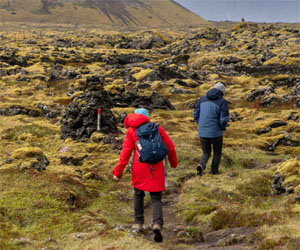
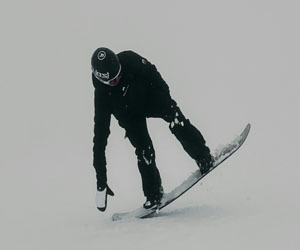



Fitness Improvement For Beginners
 2. Start Slowly: One of the most common mistakes beginners make is starting too aggressively. It's crucial to ease into your fitness routine to avoid burnout and injury. Begin with activities you enjoy and are comfortable with, even if they are less intense. You can gradually increase the intensity as your fitness level improves.
2. Start Slowly: One of the most common mistakes beginners make is starting too aggressively. It's crucial to ease into your fitness routine to avoid burnout and injury. Begin with activities you enjoy and are comfortable with, even if they are less intense. You can gradually increase the intensity as your fitness level improves.
3. Create A Structured Plan: Having a structured fitness plan can help you stay on track. This plan should include the type of exercise, the frequency, and the duration of each session. It can also be helpful to have a specific time set aside for your workouts.
4. Consistency Is Key: Consistency is the bedrock of fitness improvement. Make a commitment to sticking to your plan, even when motivation wanes. Establishing a routine and making exercise a non-negotiable part of your day will help you stay on course.
5. Embrace Variety: Variety in your workouts can keep things interesting and prevent boredom. Mix different forms of exercise, such as cardio, strength training, flexibility exercises, and even outdoor activities. Variety can also help prevent overuse injuries and promote overall fitness.
6. Listen To Your Body: Paying attention to your body is essential. If you experience pain, dizziness, or extreme discomfort during your workouts, stop immediately. Ignoring these signals can lead to injuries.
7. Proper Nutrition: A well-balanced diet is an integral part of any fitness improvement plan. Ensure you're getting the necessary nutrients to fuel your body for exercise and support recovery. Consult with a nutritionist or dietitian if needed.
8. Stay Hydrated: Proper hydration is critical for overall health and fitness. Drink enough water before, during, and after your workouts to stay properly hydrated.
Surfboard Designs For Beginners
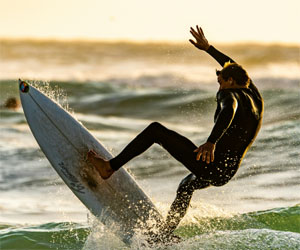 Longboards: The Stable Platform
Longboards: The Stable Platform
Longboards, often over 8 feet in length, are the classic choice for beginners. These surfboards provide unmatched stability and buoyancy, making them an ideal starting point. Key features of longboards for beginners include:
Length: Longboards are longer, which means more stability and room for paddling.
Width: Their width provides additional stability, making it easier for beginners to find their balance.
Volume: Longboards have ample volume, aiding in buoyancy and making it easier for novice surfers to catch smaller waves.
Longboards are perfect for learning the basics of paddling, balancing, and wave-catching. They offer a forgiving platform for new surfers, allowing them to gain confidence and experience the joy of riding waves.
Foam Boards: The Soft Landing
Foam boards, or soft-top surfboards, are another excellent choice for beginners. These boards are constructed with a soft, foam-covered deck, making them exceptionally safe for newcomers. Key features of foam boards include:
Safety: Foam boards reduce the risk of injury during falls, thanks to their soft construction.
Buoyancy: They offer sufficient buoyancy for easy paddling and wave-catching.
Stability: The wide and stable platform helps beginners find their balance.
The forgiving nature of foam boards makes them a popular choice for surf schools and those learning to surf for the first time.
Strategies For Success
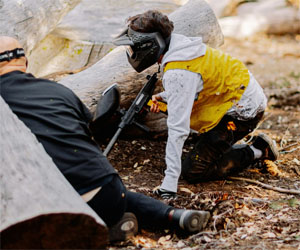 The Role Of Challenge Tactics In Paintball
The Role Of Challenge Tactics In Paintball
Challenge tactics in paintball involve tackling specific scenarios or obstacles that can impede your team's progress. These challenges can range from breaking through enemy lines to capturing a flag or defending a critical position. Mastering these tactics is essential for success in paintball, as they can turn the tide of the game in your favor.
Key Challenge Tactics In Paintball
Flag Capture And Defense: Many paintball games involve capturing flags or other objectives. To excel in this challenge, designate a team member or a group to capture the flag, while others provide cover and defend the area. Communication and coordination are vital to ensure the flag reaches its destination.
Connecting With The Avian World
 Nature As A Classroom: Birdwatching transforms the outdoors into an ever-evolving classroom. Nature lovers cherish the opportunity to learn about the diverse species of birds, their behaviors, and their habitats. Every birdwatching outing is a lesson in biology, ecology, and ornithology, providing valuable insights into the interconnectedness of all living things.
Nature As A Classroom: Birdwatching transforms the outdoors into an ever-evolving classroom. Nature lovers cherish the opportunity to learn about the diverse species of birds, their behaviors, and their habitats. Every birdwatching outing is a lesson in biology, ecology, and ornithology, providing valuable insights into the interconnectedness of all living things.
Deepening Appreciation: For nature lovers, birdwatching deepens their appreciation of the natural world. It allows them to witness the delicate beauty of birds up close, from the iridescent plumage of hummingbirds to the majestic flights of raptors. Observing birds in their habitats unveils the intricate relationships between flora and fauna.
Conservation Ethic: Birdwatching often goes hand in hand with a strong commitment to conservation. Nature lovers are acutely aware of the threats that birds and their habitats face, from habitat destruction to climate change. Their passion drives them to support initiatives aimed at preserving these vital ecosystems.
Embracing Mindfulness: Birdwatching is an exercise in mindfulness, encouraging individuals to be fully present in the moment. Nature lovers savor the tranquil rhythm of birdwatching, which allows them to escape the stresses of daily life and find solace in the natural world.
Ecosystem Exploration: Birdwatching is a journey into the diverse ecosystems that birds inhabit. Nature lovers revel in the opportunity to explore wetlands, forests, grasslands, and coastal areas, where they can connect with the beauty of these pristine landscapes.